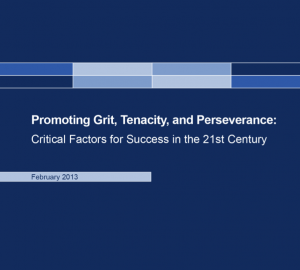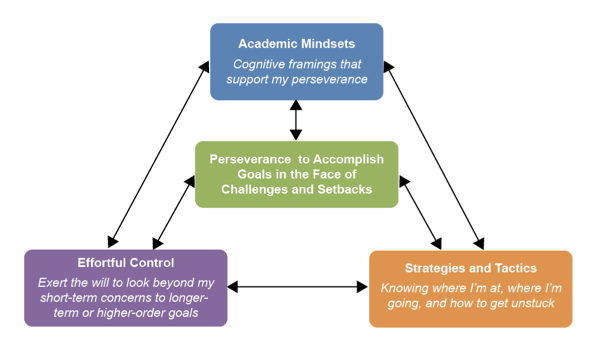
How can we best prepare children and adolescents to thrive in the 21st century? This question is at the heart of what every educator attempts to do on a daily basis. Apart from imparting content of knowledge and facts, however, it's becoming clear that the "noncognitive competencies" known as grit, perseverance, and tenacity are just as important, if not more so, in preparing kids to be self-sufficient and successful.
To that end, the Department of Education's Office of Technology has released a report called Promoting Grit, Tenacity, and Perseverance —Critical Factors for Success in the 21st Century, drafted by research firm SRI International, which addresses how educators can integrate these ideas into their teaching practice: Are these competencies malleable and teachable? How significant a role do they play in students' success? What are the best learning environments to encourage and foster these attributes?
"The test score accountability movement and conventional educational approaches tend to focus on intellectual aspects of success, such as content knowledge. However, this is not sufficient," the report states. "If students are to achieve their full potential, they must have opportunities to engage and develop a much richer set of skills."
The entire report [PDF] is well worth the read. Here are a few noteworthy highlights excerpted from different parts of the report.
What Are Grit, Tenacity, and Perseverance?
Grit, tenacity, and perseverance are multifaceted concepts encompassing goals, challenges, and ways of managing these. We integrate the big ideas from several related definitions in the literature to a broad, multifaceted definition of grit for the purpose of this report: “Perseverance to accomplish long-term or higher-order goals in the face of challenges and setbacks, engaging the student’s psychological resources, such as their academic mindsets, effortful control, and strategies and tactics.”
- Academic mindsets. These constitute how students frame themselves as learners, their learning environment, and their relationships to the learning environment. They include beliefs, attitudes, dispositions, values, and ways of perceiving oneself. Compelling evidence suggests that mindsets can have a powerful impact on academic performance in general, and in particular on how students behave and perform in the face of challenge. A core mindset that supports perseverance is called the “growth mindset”—knowing “My ability and competence grow with my effort.”
- Effortful control. Students are constantly faced with tasks that are important for long-term goals but that in the short-term do not feel desirable or intrinsically motivating. Successful students marshal willpower and regulate their attention during such tasks and in the face of distractions. While this can seem austere or “no fun,” research shows that students stronger in these skills are happier and better able to handle stress.
- Strategies and tactics. Students are also more likely to persevere when they can draw on specific strategies and tactics to deal with challenges and setbacks. They need actionable skills for taking responsibility and initiative, and for being productive under conditions of uncertainty—for example, defining tasks, planning, monitoring, changing course of action, and dealing with specific obstacles.
Measuring Grit, Tenacity, and Perseverance
There are many different types of measurement methods, each with important tradeoffs.
Self-report methods typically ask participants to respond to a set of questions about their perceptions, attitudes, goals, emotions, beliefs, and so on. Advantages are that they are easy to administer and can yield scores that are easy to interpret. Disadvantages are that people are not always valid assessors of their own skills, and self-reports can be intrusive for evaluating participants’ in-the-moment perceptions during tasks.
 Informant reports are made by teachers, parents, or other observers. Advantages are that they can sidestep inherent biases of self-report and provide valuable data about learning processes. The main disadvantage is that these measures can often be highly resource- intensive—especially if they require training observers, time to complete extensive observations, and coding videos or field notes.
Informant reports are made by teachers, parents, or other observers. Advantages are that they can sidestep inherent biases of self-report and provide valuable data about learning processes. The main disadvantage is that these measures can often be highly resource- intensive—especially if they require training observers, time to complete extensive observations, and coding videos or field notes.
Programs and Models for Learning Environments to Promote Grit, Tenacity, and Perseverance
We reviewed approximately 50 programs and models for promoting grit, tenacity, and perseverance, and developed five conceptual clusters based on targeted age level, learning environment, and which facets of the hypothesized model are addressed or leveraged. While there is still a need for more empirical evidence that these factors can be taught as transferable competencies across situations, there are a wide range of promising programs and approaches. The five conceptual clusters are as follows (discussed in detail in Chapter 4).
School readiness programs that address executive functions. These programs at the preschool and early elementary school levels help young children develop the effortful control that is necessary for the transition into formal schooling. Approaches include training with games, aerobic exercise and sports, martial arts and mindfulness practices, and classroom curricula and teacher professional development. Many programs have substantial empirical evidence of their success, and a major finding is that children best develop attention regulation and self-control when they can practice skills in a supportive environment that addresses cognitive, social, and physical development together.
Interventions that address mindsets, learning strategies, and resilience. There is growing research demonstrating that brief interventions (e.g., 2 to 10 hours) can significantly impact students’ mindsets and learning strategies, and, in turn, academic performance. Empirically based mindset interventions include activities that explicitly teach students to have a “growth mindset” (i.e., that intelligence grows with effort), help students frame difficulty not as personal failings but as important “bumps in the road” on the way to success, provide students opportunities to affirm their personal values to maintain clarity about why they are investing their efforts, help relate course materials to students’ lives, or incorporate multiple approaches to address different needs. Empirically based learning strategies interventions include those that help students clarify their goals and anticipate in advance how to deal with likely obstacles, develop general study skills, build a resource-rich social network, or develop content-specific metacognitive skills to monitor  progress. Some programs build these types of skills as protective positive assets that support resilience in the face of adversity.
progress. Some programs build these types of skills as protective positive assets that support resilience in the face of adversity.
Alternative school models and school-level reform approaches. We reviewed three types of approaches. The “character education” models include explicit articulation of learning goals for targeted competencies, clear and regular assessment and feedback of student progress, intensive teacher professional development, and discourse about these competencies throughout the school culture. In the “project-based learning and design thinking” models, students develop competencies through engagement in long-term, challenging, and/or real-world problems that require planning, monitoring, feedback, and iteration. Mindsets are addressed inherently in processes of feedback and iteration, and projects are often aligned with students’ interests and passions. The third type of approach is that of organizations providing support for schoolwide improvement, such as teacher professional development, networks of school communities, and strategies to improve school organizational structure. There is strong anecdotal evidence of these models’ success, but further research is needed to determine impacts.
Informal learning programs. We reviewed informal learning programs that provide different kinds of support for persistence. Several provide structured social support networks for students who are the first in their families to go to college. Such programs provide academic support, community involvement, and guidance in the processes of college exploration, application, and initial college adjustment. Other types of programs focus on activities to spark and support interest and persistence in STEM professions. Many programs are beginning to teach explicitly about grit, drawing on models similar to those discussed in the character education models above. In most cases, there is strong anecdotal evidence of their success, but further research is needed to determine impacts.
Digital learning environments, online resources, and tools for teachers. We reviewed educational technologies aligned with each aspect of the hypothesized model: digital learning environments that provide optimal challenge through adaptivity; digital tools to help educators promote a rigorous and supportive classroom climate; resources, information, materials, tools, or human capital to accomplish difficult goals; motivating learning environments that trigger interest; teaching about academic mindsets; promoting learning strategies; and promoting the development of effortful control. Data is available showing impacts of many of these technologies.
Learning Environments That Promote Grit
When students have big and important goals, educators can promote perseverance by providing support. Just as there is an array of types of goals, there is also a wide variety of challenges, setbacks, obstacles, and adversities that students may encounter in pursuit of their goals. We first examine this variety of challenges, and then take a close look at two dimensions of learning environments that can be important for supporting perseverance.

